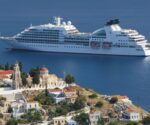I had a day in one of The Netherlands most visited spots but this city is better | Travel News | Travel
Delft is one of most visited cities in The Netherlands, with tourists drawn to its historic centre and tree-lined canals. But there’s another picturesque city about 40 miles south east which is full of charm, but without the crowds.
Dordrecht sits on the River Maas, one of the busiest waterway junctions in the world. It’s not unusual to glimpse giant container ships sailing past the old warehouses, terraces and townhouses which line the cobbled streets of the city’s old centre.
It’s not full of sights, unlike nearby Delft, but that is part of its appeal. Delft’s central square, the Markt, can be heaving with selfie-snapping visitors during the day, as tourists position themselves into shots of the grand Stadhuis and impressive Nieuwe Kirk opposite.
But Dordrecht, which was once the most powerful town in the Province of Holland, has a calmer feel in comparison to its bustling neighbour.
The main attraction is the Gothic Grote Kerk, which is one of the largest churches in The Netherlands and built to show off Dordrecht’s importance.
It’s a bit disappointing inside after Protestants did away with its decoration and ornamentation, but the church’s exterior is impressive, with a tower topped off with 17th century clocks. You can climb the tower too for amazing views over the city and nearby waterways.
Other than Grote Kerk, there isn’t much more by way of sights besides Dordrechts Museum and the Wijnhaven harbour. This last is well-worth a visit, with views of barges and sailing boats surrounded by old warehouses, most if not all of which have been converted into homes.
It’s also a short walk away from Groothoofdspoort Gate, which used to be the main entry to the city. There’s a couple of eateries nearby where you can sit outside and watch ships pass by on the River Maas.
A few minutes away on foot is Voorstraat, Dordrecht’s main shopping street, which opens onto alleyways lined with more restaurants, businesses and independent shops as well as big chainstores. Some of those shops were also vacant. With some UK high streets struggling too, the empty shops made it feel like home.
Outside the old centre lies modern Dordrecht, which felt grittier and busier. It feels as if here is a city not just there to meet the needs of tourists, but which bustles with locals.
Another advantage Dordrecht offers is its proximity to the National Park de Biesbosch – one of Europe’s last remaining freshwater tidal areas. Covered by the tide twice a day, the park boasts wetlands where birds can include kingfishers, ducks and geese.
A car ride away – or cycle ride if you’re feeling adventurous – is Werelderfgoed Kinderdijk, UNESCO World Heritage site. Head here for a classic view of Dutch windmills.
Despite the midges, this spot offers great views and feels really tranquil, even though it is just outside one of the largest ports in the world at Rotterdam.
And this is another part of Dordrecht’s appeal. It’s close enough to bigger, busy cities with amazing sights – including The Hague and Rotterdam – but the pace is slower and much more laid back, making it the perfect place to return to after a day’s sightseeing.
Dordrecht is also very well connected. The train station is about 20 minutes away from the old centre and there are frequent connections to Delft, Rotterdam, The Hague and elsewhere.
But for great views of the city and surrounding area, jump on a waterbus between Dordrecht and Rotterdam’s impressive Erasmusbrug. The journey is about 45 minutes, but well worth it as the boat speeds along the Maas, racing past cargo ships, barges and sailing boats for a single fare priced £6.12 (€7.20) at the time of writing.
To get to Dordrecht, I took the Eurostar from London St Pancras to Rotterdam and jumped on a train from Rotterdam Central to the city. There’s no airport in Dordrecht but there are direct flights to Rotterdam with BA and transavia.








